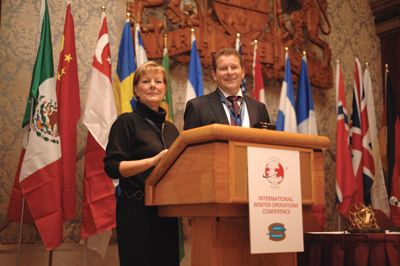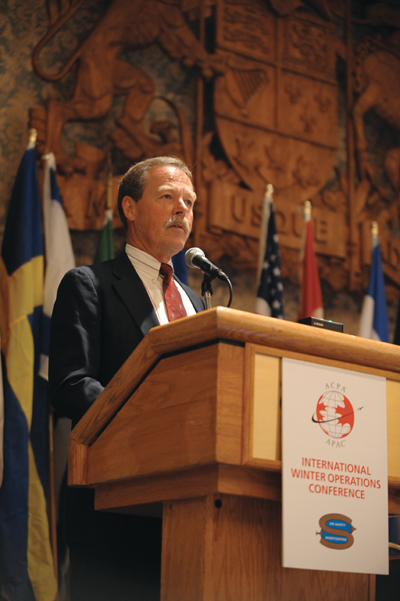
Features
Operations
The Cold, Hard Facts
Canadian pilots take for granted that they will fly some, if not most of their careers in winter conditions. For them, learning to operate safely in winter literally comes with the territory.
February 5, 2010 By Paul Howard
Canadian pilots take for granted that they will fly some, if not most of their careers in winter conditions. For them, learning to operate safely in winter literally comes with the territory. But with the ever-increasing range of aircraft, more and more operators based in warmer climates are flying into winter conditions, without years of experience dealing with the challenges that cold weather brings for equipment, operations and maintenance. They could benefit from the lessons learned from the cold, hard facts of life in Canadian aviation. This was the genesis of the first-ever International Winter Operations Conference, hosted Oct. 7 and 8 in Toronto by the Air Canada Pilots Association (ACPA) and the Canadian Society of Air Safety Investigators (CSASI).
 |
|
| Barbara Dunn, president of the Canadian Society of Air Safety Investigators, stands with Captain Barry Wiszniowski, chair of ACPA’s Technical and Safety Division and co-chair of the conference.
|
“We have 3,000 pilots with experience operating in the Canadian winter environment,” said Captain Barry Wiszniowski, chair of ACPA’s Technical and Safety Division and co-chair of the conference. “This is an area of expertise we wanted to share with the industry and foreign carriers coming into Canada, because operating in icing conditions is anything but normal for many of them. Some have never seen ice before. For us, winter operations are normal operating procedures.”
The theme of the first “Winterops” conference was “Safety Is No Secret.” It drew together experts from manufacturers, operators, airports, maintenance, services and regulators, all bringing their specialized knowledge and lessons learned in the field. The aviation industry clearly has an appetite for information on safe winter operations. More than 200 people from 16 countries around the world came to learn. Here’s some of what they heard:
Former NASA astronaut Commander Robert “Hoot” Gibson’s opening address catalogued the lessons the space agency learned – but did not heed – about operating the space shuttle in cold temperatures, culminating in the loss of two shuttles and massive changes that set the shuttle program back for years. Jeanne Mason of Boeing’s Propulsion Systems Division explained the growth in understanding of how ice crystals can lead to engine power loss and gave insights that can help pilots recognize the weather conditions that can lead to such events. Barbara Dunn, president of the Canadian Society of Air Safety Investigators, described the lessons learned during evacuations of passengers into severe weather conditions and steps that can be taken to better prepare them and flight crews to handle this challenge.
 |
|
| Former NASA astronaut Commander Robert “Hoot” Gibson’s opening address catalogued the lessons the space agency has learned about operating the space shuttle in cold temperatures.
|
With their special expertise and experience, the presenters each provided the benefit of their learning in their particular field of winter operations. By all accounts, the lessons were well received. “We learned a lot about techniques and technological advances that will make operations safer, as well as some of the traps we can avoid,” Captain Wiszniowski said. “I travelled privately at my own expense from Germany,” said Gary Tarizzo. “I thought the conference was very informative and worth the effort to attend. I learned a great deal.” “Through this conference, we’re also getting together as a community,” Captain Wiszniowski said. “For example, we discovered that air traffic controllers didn’t know that, as part of our standard operational procedures in icing conditions, pilots have to do an engine run-up on the runway before takeoff. Through the education process, with contributions from everyone involved in winter operations, we can eliminate or reduce risks all around.”
“It’s this kind of partnership, working together to improve aviation safety, that will raise standards right across our industry, for the benefit of everyone working in it, as well as our customers,” said ACPA president Captain Paul Strachan. But there’s still much yet to learn. “We don’t fully understand the characteristics of a deicing fluid failure. We need to share the lessons we’ve learned about wing and airframe contamination and what level of contamination could lead to a serious event. We need to emphasize the effect of an unstable approach and the extent of noncompliance with standard operating procedures that may put you in harm’s way,” Captain Wiszniowski said.
For that reason, Winterops will reconvene in Canada in two year's time, giving the industry time to improve its technology and refine its practices before bringing more lessons to the table. “We don’t talk about it a lot, but the entire Canadian aviation industry has become very good at moving passengers and cargo safely and efficiently in one of the harshest environments on earth,” Captain Strachan said. “Our climate has forced us to become experts on winter operations. We want to share that expertise with the rest of the world.”